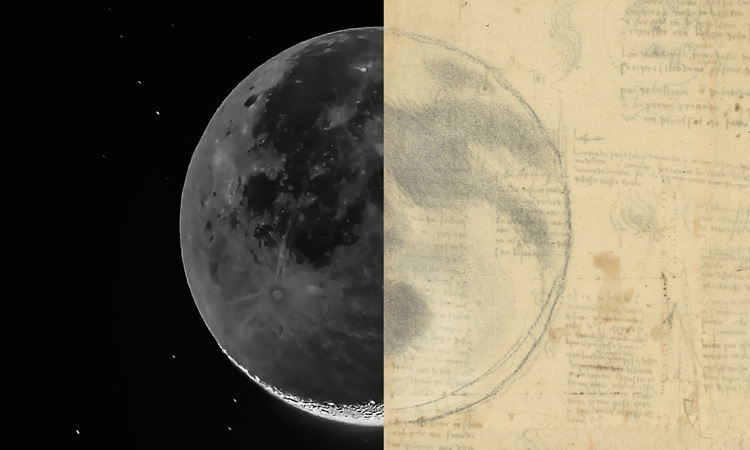Feature
Did Leonardo da Vinci Invent the Telescope?
An analysis of one of the Italian master’s early-16th-century notebooks suggests that his experiments may have extended to combining lenses to achieve a better view of the moon.
 Image of the moon alongside a drawing of the moon by Leonardo (only half of which survives), from the Codex Atlanticus (f. 674v). [Left side of moon: Getty Images / Codex Atlanticus image: © Veneranda Biblioteca Ambrosiana/Metis e Mida Informatica/Mondadori Portfolio/Bridgeman Images]
Image of the moon alongside a drawing of the moon by Leonardo (only half of which survives), from the Codex Atlanticus (f. 674v). [Left side of moon: Getty Images / Codex Atlanticus image: © Veneranda Biblioteca Ambrosiana/Metis e Mida Informatica/Mondadori Portfolio/Bridgeman Images]
A note on citations: In describing material from Leonardo da Vinci’s notebooks, we give the folio—the number denoting where the individual page or leaf falls within the notebook—and whether the cited material is on the front (recto or “r”) or back (verso or “v”). Thus, for example, “f. 518r” of the Codex Atlanticus appears on the front side of the 518th leaf in the codex.
The Codex Atlanticus of Leonardo da Vinci, encompassing the Italian master’s notebooks from 1478 to 1519, includes a curious sentence written by him in 1513–14—in the famous right-to-left “mirror writing” common in his notebooks. When flipped horizontally, the sentence reads: Fa ochiali per veder la luna grande (f. 518r)—which translates literally to English as “Make glasses to see the moon big.” Ochiali is from Italian occhio for eye; it shows that Leonardo is writing about a system of lenses. (A century later, Galileo Galilei would use the occhiale to denote his telescope.)
…Log in or become a member to view the full text of this article.
This article may be available for purchase via the search at Optica Publishing Group.
Optica Members get the full text of Optics & Photonics News, plus a variety of other member benefits.
